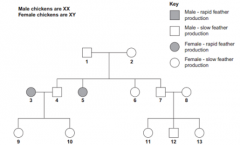![]()
![]()
![]()
Use LEFT and RIGHT arrow keys to navigate between flashcards;
Use UP and DOWN arrow keys to flip the card;
H to show hint;
A reads text to speech;
15 Cards in this Set
- Front
- Back
|
What is meant by codominant alleles? [1] |
-both alleles expressed in the phenotype |
|
|
In cats, males are XY and females are XX. A gene on the X chromosome controls fur colour in cats. The allele G codes for ginger fur and the allele B codes for black fur. These alleles are codominant. Heterozygous females have ginger and black patches of fur and their phenotype is described as tortoiseshell. Male cats with the tortoiseshell phenotype do not usually occur. Explain why [1] |
-The Y chromosome doesn’t carry the gene and male cats don’t have an X chromosome |
|
|
A tortoiseshell female was crossed with a black male. Use a genetic diagram to show all the possible genotypes and the ratio of phenotypes expected in the offspring of this cross. Use XG to indicate the allele G on an X chromosome. Use XB to indicate the allele B on an X chromosome [3] |
-XGXB, XBXB, XGY,XBY -Tortoiseshell female, black female, ginger male, black female -Ratio = 1:1:1:1 |
|
|
The allele for polydactyly is dominant. Some cat breeders select FOR polydactyly. Explain how this would affect the frequencies for the homozygous genotypes for this gene in their breeding populations over time [1] |
-Homozygous dominant increases and homozygous recessive decreases |
|
|
On islands in the Caribbean, there are almost 150 species of lizards belonging to the genus Anolis. Scientists believe that these species evolved from two species found on mainland USA. Explain how the Caribbean species could have evolved [6] |
-Geographical isolation -Separate gene pools -Variation due to mutation -Different selection pressures -Differential reproductive success -Leads to divergent increases in allele frequencies -Creating new species |
|
|
Anolis sagrei is a species of lizard that is found on some of the smallest Caribbean islands. Describe how you could use the mark-release-recapture method to estimate the number of Anolis sagrei on one of these islands [4] |
-Collect sample, mark and release -Method of marking should not cause harm or make more visible to predators -Leave sufficient time for lizards to randomly distribute before collecting second sample -Population = (number in first sample * number in second sample) / number marked in second sample |
|
|
In birds, males are XX and females are XY. Use this information to explain why recessive, sex-linked characteristics are more common in female birds than male birds [2 |
-Recessive allele is always expressed in females -Because they only have one allele |
|

In chickens, a gene on the X chromosome controls the rate of feather production. The allele for slow feather production, F, is dominant to the allele for rapid feather production, f. The figure below shows the results produced from crosses carried out by a farmer. Explain one piece of evidence from the figure above which shows that the allele for rapid feather production is recessive [2] |
-1, 2, and 5 -1 must carry the recessive allele -If slow feather production was recessive, all offspring from 1 and 2 would have rapid |
|
|
Explain the results of frequency of an allele as a ratio [2] |
-Allows easier comparison -Sample size may vary |
|
|
Explain what is meant by the term phenotype [2] |
-Expression of a characteristic due to alleles -Which alter a characteristic |
|
![Explain one piece of evidence which shows that the allele for this disease is recessive [2]](https://images.cram.com/images/upload-flashcards/23/48/37/18234837_m.png)
Explain one piece of evidence which shows that the allele for this disease is recessive [2] |
-3 and 4 and 9 and 11 are affected offspring -Therefore both 3 and 4 are heterozygous |
|
|
Explain once piece of evidence from the diagram above which proves that the allele for this disease is NOT on the X chromosome [2] |
-11 is affected, 3 is not -Therefore father of 11 does not have a recessive allele on his X chromosome |
|
|
The fruit fly is a useful organism for studying genetic crosses. Female fruit flies are approximately 2.5 mm long. Males are smaller and possess a distinct black patch on their bodies. Females lay up to 400 eggs which develop into adults in 7 to 14 days. Fruit flies will survive and breed in small flasks containing a simple nutrient medium consisting mainly of sugars. Use this information to explain TWO reasons why the fruit fly is a useful organism for studying genetic crosses [2] |
-Large numbers of offspring so large sample size -Small size so can be easily stored -Size and markings make females easy to identify -Short generation time so can make many generations fast |
|
|
Suggest one reason why observed ratios are often not the same as expected ratios when performing genetic crosses [1] |
-Fertilisation is a random process |
|
|
When a recessive allele is carried on the X chromosome, XY males are more likely to show the phenotype for the allele than XX females. Explain why [2] |
-Males only have one allele -Females need two recessive alleles to express phenotype |

